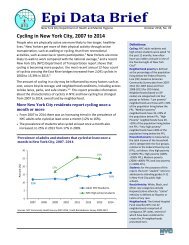2013-dot-sustainable-streets-lowres
2013-dot-sustainable-streets-lowres
2013-dot-sustainable-streets-lowres
Create successful ePaper yourself
Turn your PDF publications into a flip-book with our unique Google optimized e-Paper software.
INFRASTRUCTURELooking AheadContinued progress on the infrastructure maintenance outlinedabove will require a substantial investment.The agency’s bridge reconstruction program for the next tenyears totals $4.3 billion. Over 70 bridges that would otherwisefall into “poor” condition are slated be reconstructed over thistime, including the Unionport Bridge in the Bronx and RooseveltAvenue over the Van Wyck Expressway in Queens. Analysis ofbridge conditions shows growing needs going forward, as moreof our bridges age. Maintenance costs increase as bridges getolder, so repairing bridges on time will save public funds in thelong run.The design process for three new Staten Island Ferry boats isunderway to service the next generation of Staten Island Ferryriders. Procurement of those boats will cost $300 million andrequire government resources—so far federal funding has notbeen secured.An additional $2.4 billion in city funds is programmed forstreet reconstruction and repaving, allocations that arenecessary for the safe movement of buses, trucks, cars, andbicycles. PlaNYC’s analysis showed that the City needs toresurface at least 900 lane miles per year in order to return thecity’s <strong>streets</strong> to a state of good repair, so anything less than thiswill have consequences in terms of safety, mobility and vehiclemaintenance.Sustaining these investment levels will be challenging. Theneeds above are in addition to those of the MTA, which runssubways, commuter trains and buses, and has a multi–billiondollar hole in its next capital construction program, and comeat a time of eroding federal transportation aid. As a percentageof U.S. GDP, investment in infrastructure today is half whatit was in 1960, according to the National Association ofCity Transportation Officials. The United States is investingapproximately two percent of GDP on infrastructure; Europeand China are investing approximately five percent and ninepercent. Growth in India, China, Brazil and other surgingeconomies is being fueled by investment in urban transportationsystems while the U.S. lags behind.But the region will have no option but to find revenue necessary.Ignoring vital bridge, road, and transit maintenance would havedisastrous consequences on the region’s mobility and economicvitality, as evidenced by the deterioration of the NYC subwaysystem in the 70s and 80s. Deferring maintenance will also leadto higher costs in the long run.New sources of revenue will be necessary, such as East RiverBridge tolls or a congestion charging program that levies feeson drivers coming in Manhattan’s central business district. (seeMobility Looking Ahead section).The agency will also have to find ways to preserve its currentinvestments, and reduce maintenance costs. Despite progress toprotect recently repaved <strong>streets</strong> from construction work, <strong>streets</strong>are frequently torn up in New York or not repaired to adequatestandards after construction. The Street Works Manual attemptsto address this. Greater knowledge of and use of this documentcould help protect the city’s street and bridge investments.The agency will also have to find new and innovative ways tocommunicate with New Yorkers about the core maintenancework it undertakes. The model set by The Daily Pothole couldbe expanded to other areas, and help make a case for the newrevenue programs.Realigning transportation infrastructure to better reflect theneeds of the surrounding community could produce cost savingsand offset previously inflicted impacts of large infrastructureprojects. Turning the Sheridan Expressway in the South Bronxinto a boulevard, as proposed by the city’s Sheridan/Hunts PointLand Use and Transportation Study, would improve access to newparks along the Bronx River, greatly enhance safety, and providenew development opportunities. As vacant city land becomesscarcer, proposals to deck over other highways, like the BrooklynQueens Expressway in Williamsburg or through Cobble Hill, couldprovide new opportunities for parks and housing.Sustainable Streets: <strong>2013</strong> and Beyond191



